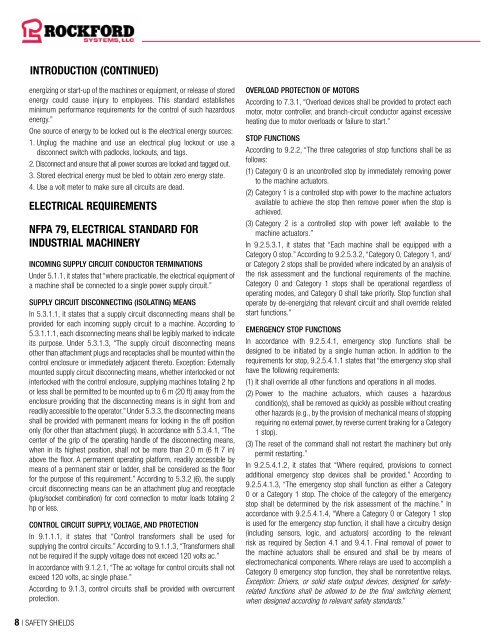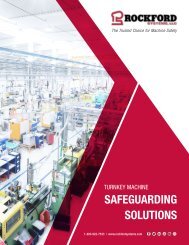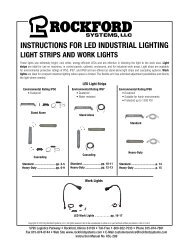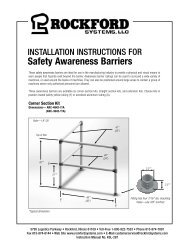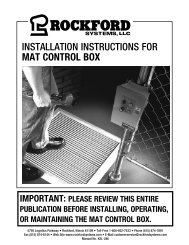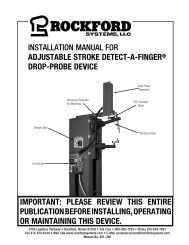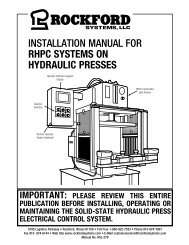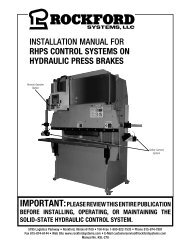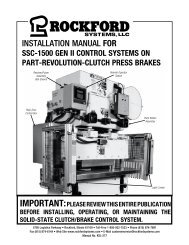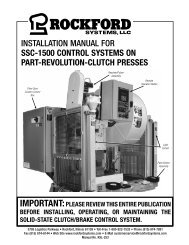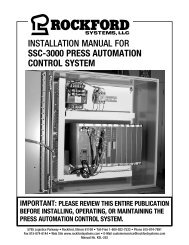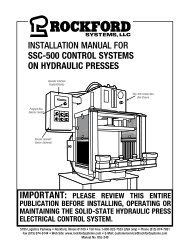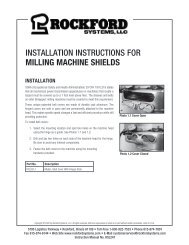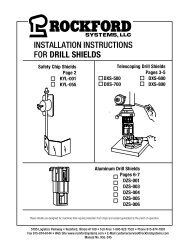Rockford Systems Shields for Safeguarding Machines Catalog
FREE, comprehensive 80-page catalog that features a complete line of equipment to protect operators of cutting and turning machines. These products comply with OSHA and ANSI standards. The polycarbonate and steel shields found in this catalog can be applied to drill presses, lathes, milling machines, bench grinders, band saws, and disc and belt sanders. The catalog also offers emergency-stop devices, disconnect switches, magnetic motor starters, lockouts, and danger signs.
FREE, comprehensive 80-page catalog that features a complete line of equipment to protect operators of cutting and turning machines. These products comply with OSHA and ANSI standards. The polycarbonate and steel shields found in this catalog can be applied to drill presses, lathes, milling machines, bench grinders, band saws, and disc and belt sanders. The catalog also offers emergency-stop devices, disconnect switches, magnetic motor starters, lockouts, and danger signs.
- No tags were found...
Create successful ePaper yourself
Turn your PDF publications into a flip-book with our unique Google optimized e-Paper software.
INTRODUCTION (CONTINUED)<br />
energizing or start-up of the machines or equipment, or release of stored<br />
energy could cause injury to employees. This standard establishes<br />
minimum per<strong>for</strong>mance requirements <strong>for</strong> the control of such hazardous<br />
energy.”<br />
One source of energy to be locked out is the electrical energy sources:<br />
1. Unplug the machine and use an electrical plug lockout or use a<br />
disconnect switch with padlocks, lockouts, and tags.<br />
2. Disconnect and ensure that all power sources are locked and tagged out.<br />
3. Stored electrical energy must be bled to obtain zero energy state.<br />
4. Use a volt meter to make sure all circuits are dead.<br />
ELECTRICAL REQUIREMENTS<br />
NFPA 79, ELECTRICAL STANDARD FOR<br />
INDUSTRIAL MACHINERY<br />
INCOMING SUPPLY CIRCUIT CONDUCTOR TERMINATIONS<br />
Under 5.1.1, it states that “where practicable, the electrical equipment of<br />
a machine shall be connected to a single power supply circuit.”<br />
SUPPLY CIRCUIT DISCONNECTING (ISOLATING) MEANS<br />
In 5.3.1.1, it states that a supply circuit disconnecting means shall be<br />
provided <strong>for</strong> each incoming supply circuit to a machine. According to<br />
5.3.1.1.1, each disconnecting means shall be legibly marked to indicate<br />
its purpose. Under 5.3.1.3, “The supply circuit disconnecting means<br />
other than attachment plugs and receptacles shall be mounted within the<br />
control enclosure or immediately adjacent thereto. Exception: Externally<br />
mounted supply circuit disconnecting means, whether interlocked or not<br />
interlocked with the control enclosure, supplying machines totaling 2 hp<br />
or less shall be permitted to be mounted up to 6 m (20 ft) away from the<br />
enclosure providing that the disconnecting means is in sight from and<br />
readily accessible to the operator.” Under 5.3.3, the disconnecting means<br />
shall be provided with permanent means <strong>for</strong> locking in the off position<br />
only (<strong>for</strong> other than attachment plugs). In accordance with 5.3.4.1, “The<br />
center of the grip of the operating handle of the disconnecting means,<br />
when in its highest position, shall not be more than 2.0 m (6 ft 7 in)<br />
above the floor. A permanent operating plat<strong>for</strong>m, readily accessible by<br />
means of a permanent stair or ladder, shall be considered as the floor<br />
<strong>for</strong> the purpose of this requirement.” According to 5.3.2 (6), the supply<br />
circuit disconnecting means can be an attachment plug and receptacle<br />
(plug/socket combination) <strong>for</strong> cord connection to motor loads totaling 2<br />
hp or less.<br />
CONTROL CIRCUIT SUPPLY, VOLTAGE, AND PROTECTION<br />
In 9.1.1.1, it states that “Control trans<strong>for</strong>mers shall be used <strong>for</strong><br />
supplying the control circuits.” According to 9.1.1.3, “Trans<strong>for</strong>mers shall<br />
not be required if the supply voltage does not exceed 120 volts ac.”<br />
In accordance with 9.1.2.1, “The ac voltage <strong>for</strong> control circuits shall not<br />
exceed 120 volts, ac single phase.”<br />
According to 9.1.3, control circuits shall be provided with overcurrent<br />
protection.<br />
OVERLOAD PROTECTION OF MOTORS<br />
According to 7.3.1, “Overload devices shall be provided to protect each<br />
motor, motor controller, and branch-circuit conductor against excessive<br />
heating due to motor overloads or failure to start.”<br />
STOP FUNCTIONS<br />
According to 9.2.2, “The three categories of stop functions shall be as<br />
follows:<br />
(1) Category 0 is an uncontrolled stop by immediately removing power<br />
to the machine actuators.<br />
(2) Category 1 is a controlled stop with power to the machine actuators<br />
available to achieve the stop then remove power when the stop is<br />
achieved.<br />
(3) Category 2 is a controlled stop with power left available to the<br />
machine actuators.”<br />
In 9.2.5.3.1, it states that “Each machine shall be equipped with a<br />
Category 0 stop.” According to 9.2.5.3.2, “Category 0, Category 1, and/<br />
or Category 2 stops shall be provided where indicated by an analysis of<br />
the risk assessment and the functional requirements of the machine.<br />
Category 0 and Category 1 stops shall be operational regardless of<br />
operating modes, and Category 0 shall take priority. Stop function shall<br />
operate by de-energizing that relevant circuit and shall override related<br />
start functions.”<br />
EMERGENCY STOP FUNCTIONS<br />
In accordance with 9.2.5.4.1, emergency stop functions shall be<br />
designed to be initiated by a single human action. In addition to the<br />
requirements <strong>for</strong> stop, 9.2.5.4.1.1 states that “the emergency stop shall<br />
have the following requirements:<br />
(1) It shall override all other functions and operations in all modes.<br />
(2) Power to the machine actuators, which causes a hazardous<br />
condition(s), shall be removed as quickly as possible without creating<br />
other hazards (e.g., by the provision of mechanical means of stopping<br />
requiring no external power, by reverse current braking <strong>for</strong> a Category<br />
1 stop).<br />
(3) The reset of the command shall not restart the machinery but only<br />
permit restarting.”<br />
In 9.2.5.4.1.2, it states that “Where required, provisions to connect<br />
additional emergency stop devices shall be provided.” According to<br />
9.2.5.4.1.3, “The emergency stop shall function as either a Category<br />
0 or a Category 1 stop. The choice of the category of the emergency<br />
stop shall be determined by the risk assessment of the machine.” In<br />
accordance with 9.2.5.4.1.4, “Where a Category 0 or Category 1 stop<br />
is used <strong>for</strong> the emergency stop function, it shall have a circuitry design<br />
(including sensors, logic, and actuators) according to the relevant<br />
risk as required by Section 4.1 and 9.4.1. Final removal of power to<br />
the machine actuators shall be ensured and shall be by means of<br />
electromechanical components. Where relays are used to accomplish a<br />
Category 0 emergency stop function, they shall be nonretentive relays.<br />
Exception: Drivers, or solid state output devices, designed <strong>for</strong> safetyrelated<br />
functions shall be allowed to be the final switching element,<br />
when designed according to relevant safety standards.”<br />
8 | SAFETY SHIELDS


